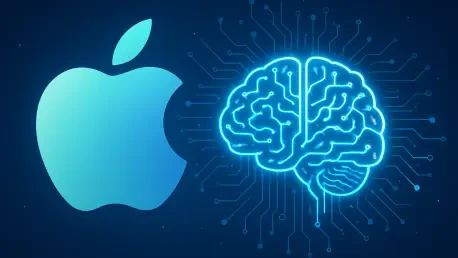In an era where artificial intelligence is rapidly transforming the way people live and work, Apple has emerged as a formidable player with its groundbreaking initiative, Apple Intelligence, signaling a seismic shift in how technology integrates seamlessly into daily life. Far from being just another tech trend, Apple Intelligence aims to deliver practical, user-focused tools that enhance productivity and personalization while maintaining a staunch commitment to privacy. With innovations poised to redefine interactions with devices and a strategic approach to deployment, Apple is not merely following the AI wave but actively shaping its trajectory. The implications of this endeavor stretch across users, developers, and the broader industry, raising questions about how deeply AI can embed into everyday experiences without compromising security or trust. This exploration delves into Apple’s unique contributions and the potential long-term impact on the tech landscape.
Pioneering User-Centric AI Solutions
Apple Intelligence stands out in the crowded AI arena by prioritizing solutions that directly address real user needs, a focus that sets it apart from more experimental approaches. CEO Tim Cook has emphasized features like Live Translation for seamless communication across languages, Visual Intelligence for enhanced visual recognition, and advanced tools for photo editing and content creation. These aren’t just flashy add-ons but practical enhancements designed to make technology more intuitive and helpful in everyday scenarios. By embedding these capabilities into its ecosystem, Apple ensures that users can leverage AI without needing to navigate complex interfaces or sacrifice functionality. This dedication to usability reflects a broader industry shift toward making AI accessible, but Apple’s execution, backed by its robust hardware and software integration, positions it as a leader in turning abstract potential into tangible benefits for millions around the globe.
Beyond the features themselves, Apple’s approach to AI processing marks a significant departure from the norm, emphasizing data security in a way few competitors can match. Powered by Apple Silicon chips, Apple Intelligence largely operates on-device, meaning sensitive user information doesn’t need to travel to external servers for processing. This method tackles growing concerns about data breaches and privacy violations head-on, especially in an era where cyber threats loom large. Unlike many tech giants that rely heavily on cloud-based systems, Apple’s strategy minimizes exposure to external risks, offering users peace of mind. Additionally, the Private Cloud Compute system provides a secure fallback for tasks requiring more power, ensuring that even off-device processing adheres to stringent privacy standards. This balance of innovation and protection could redefine consumer expectations, pushing the industry to prioritize security as a core component of AI development rather than an afterthought.
A Measured Path to Transformative Releases
Apple’s rollout of Apple Intelligence is characterized by a deliberate pace, reflecting a commitment to quality over haste in an industry often criticized for rushed launches. Significant updates, including a revamped Siri with deeper contextual understanding, are slated for this year, with more comprehensive features expected by 2026. This timeline, as outlined by Tim Cook, underscores a strategy focused on refining technology to ensure reliability and a polished user experience. Rather than flooding the market with half-baked tools, Apple appears intent on avoiding the pitfalls of early performance issues that can erode trust. Such caution is particularly relevant in AI, where user adoption often hinges on seamless functionality from day one. By taking this measured approach, Apple not only builds anticipation but also sets a precedent for how complex technologies should be introduced, potentially influencing competitors to adopt similar rigor in their deployment strategies.
This strategic pacing also allows Apple to address feedback and fine-tune features before they reach a global audience, a process that could prove critical to long-term success. Early beta testing has reportedly revealed some performance hiccups, a common challenge in cutting-edge tech development, but Apple’s transparent acknowledgment of ongoing progress suggests confidence in overcoming these obstacles. The focus on a personalized Siri, capable of understanding user intent based on situational cues, hints at a future where digital assistants are far more than voice-activated search tools. Instead, they could become proactive companions tailored to individual habits and needs. If executed well, this evolution might shift how users perceive and interact with their devices, cementing Apple’s role as an innovator in AI-driven personalization. The broader rollout planned for next year will likely serve as a litmus test for whether this patience pays off in delivering truly transformative experiences.
Empowering Ecosystems for Users and Creators
The scope of Apple Intelligence extends well beyond enhancing consumer gadgets; it promises to reshape how users engage with technology on a fundamental level. For everyday users, the integration of smarter tools across Apple’s product lineup means tasks like drafting emails, editing images, or managing fitness goals could become more intuitive and efficient. Imagine a device that anticipates needs based on usage patterns, offering suggestions before they’re even requested. This level of personalization aims to save time and reduce friction in daily routines, elevating the role of technology from a mere utility to a genuine partner. As these capabilities roll out, they could redefine expectations for what smartphones, tablets, and wearables should achieve, pushing other companies to match or exceed Apple’s benchmarks in user experience design to remain competitive in a rapidly evolving market.
Equally impactful is Apple Intelligence’s potential to invigorate the developer community, fostering a new wave of creativity within the Apple ecosystem. By providing access to Apple Foundation Models, the company equips developers with powerful AI resources to build innovative applications that can leverage these advanced capabilities. This move isn’t just about enhancing existing apps but about inspiring entirely new categories of software that could transform industries like education, healthcare, or entertainment. For instance, developers might craft tools that offer real-time learning assistance or personalized wellness plans, directly tapping into Apple’s AI framework. Such opportunities strengthen the symbiotic relationship between Apple and its developer base, ensuring a steady stream of fresh content and functionalities. This dual focus on empowering users and creators alike positions Apple to maintain a vibrant, dynamic ecosystem that continuously evolves to meet diverse needs.
Navigating Collaborations and Scalability Hurdles
Apple’s journey with AI isn’t a solitary one, as hinted by Tim Cook’s discussions with external AI providers such as Google and Anthropic for potential integrations. These prospective partnerships suggest a willingness to expand capabilities through collaboration while adhering to Apple’s rigorous standards for privacy and performance. Any agreements would likely involve strict service level agreements to ensure consistency with Apple’s user experience ethos. This openness to third-party involvement marks a pragmatic approach, recognizing that no single entity can dominate every facet of AI innovation. If successful, such collaborations could accelerate the adoption of advanced features across Apple’s platforms, offering users a broader range of tools without compromising the core values that define the brand. The challenge lies in aligning these external systems with Apple’s ecosystem, a process that will test the company’s ability to balance control with flexibility.
However, scaling AI to billions of users presents significant challenges, not just for Apple but for the entire industry, as infrastructure constraints come into sharp focus. Limitations in energy, water, and hardware resources pose real barriers to delivering AI at a global scale, and while Apple’s on-device processing model mitigates some dependency on external systems, third-party partners may struggle to keep pace. These providers will need substantial investments to expand their capacity, which could delay widespread integration of their tools into Apple’s framework. Apple’s emphasis on localized processing offers a partial solution by reducing reliance on massive data centers, but the broader issue of sustainable scaling remains unresolved. Addressing these hurdles will be crucial for ensuring that the promise of Apple Intelligence reaches its full potential without being hamstrung by logistical bottlenecks that could frustrate users and developers alike.
Building Trust Through Privacy Leadership
At the core of Apple Intelligence lies an unwavering focus on privacy, a principle that has long distinguished Apple in the tech world and continues to shape its AI strategy. By prioritizing on-device processing, Apple ensures that personal data remains under user control, minimizing the risks associated with cloud-based systems that can be vulnerable to breaches. The Private Cloud Compute system further bolsters this approach, offering a secure environment for tasks that require additional computational power without sacrificing data protection. In an age where consumers are increasingly wary of how their information is handled, this commitment to security serves as a powerful differentiator. It not only reassures users but also aligns with stringent regulatory demands in regions with robust data protection laws, potentially giving Apple an edge in markets where privacy concerns heavily influence purchasing decisions.
This emphasis on safeguarding user information could set a new standard for the industry, challenging competitors to elevate their own privacy practices. As AI becomes more pervasive, touching everything from personal communications to financial transactions, the demand for trustworthy systems will only grow. Apple’s proactive stance positions it as a leader in fostering consumer confidence, potentially influencing how future technologies are designed and deployed across the sector. If other companies follow suit, the result could be a safer digital landscape where users feel empowered rather than exposed. Moreover, Apple’s focus on privacy isn’t just a technical feature but a cultural statement, reinforcing the idea that innovation need not come at the expense of personal security. This philosophy may well become a benchmark, shaping public expectations and regulatory frameworks for years to come as AI continues to evolve.
Reflecting on a Legacy of Innovation
Looking back, Apple Intelligence emerged as a pivotal chapter in the company’s storied history of redefining technology, blending cutting-edge AI with a steadfast commitment to user trust. The journey, marked by strategic rollouts and a focus on privacy through on-device processing, showcased how Apple navigated the complexities of a rapidly advancing field with finesse. Collaborations with external AI providers and the empowerment of developers through Apple Foundation Models highlighted a balanced approach to growth, while addressing scalability challenges demonstrated foresight. Moving forward, the tech industry can draw lessons from this era by prioritizing quality and security in AI deployments. Stakeholders should consider investing in sustainable infrastructure to support global AI expansion and advocate for policies that protect user data. As the landscape evolves, Apple’s efforts stand as a reminder that meaningful innovation requires patience, collaboration, and an unwavering focus on the end user.









